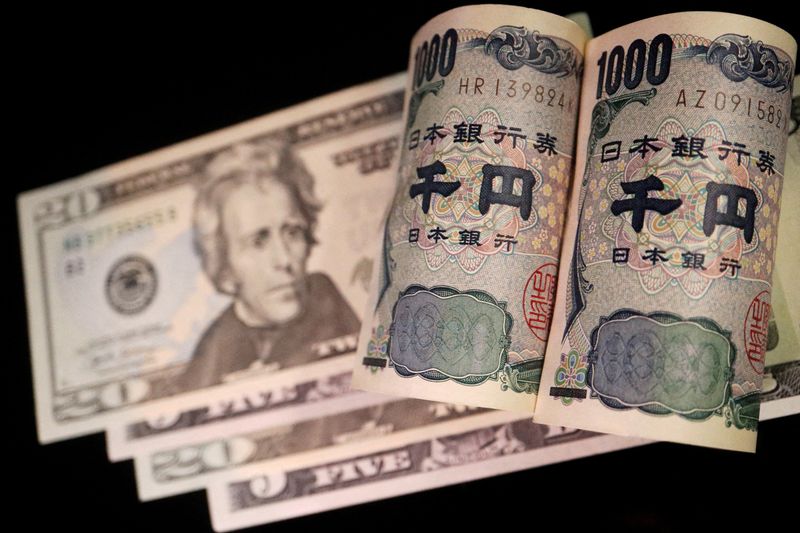By Vidya Ranganathan
SINGAPORE (Reuters) - Even as the Bank of Japan prepares for a pivotal change in monetary policy, analysts say much more will need to be done to materially shift the roughly $3 trillion of yen Japanese investors have parked in global bond markets and yen trades.
Japanese investors have invested trillions of yen overseas in their quest to earn anything better than the near-zero returns at home under the BOJ's decades-long effort to end deflation.
The BOJ might change that policy as soon as this week. Rising wages and other business activity suggest stagnation is over, meaning little need for the BOJ to continue to keep short-term rates negative.
Anticipation of better growth has drawn foreign money into Japanese stocks and driven yen bond yields higher.
It has also put the spotlight on the $2.4 trillion of foreign debt Japan's life insurance companies, pension funds, banks and trust firms collectively hold, and how much of those investment flows will return home.
But these holdings earn yen investors upwards of 5%, so investors will barely react if the BOJ raises its rates by 10 or 20 basis points, analysts say.
"I honestly don't think it will have a big impact on flows," says Alex Etra, a senior strategist at analytics firm Exante Data.
Japan's overall foreign portfolio investments were 628.45 trillion yen ($4.2 trillion) at the end of December, Ministry of Finance data shows - more than half in interest rate-sensitive debt assets, and most of it long term.
The BOJ embarked on its quantitative and qualitative easing (QQE) in May 2013. Between then and now, Japanese investment in foreign debt was about 89 trillion yen, nearly 60% of which belonged to pension funds, including the giant Government Pension Investment Fund or GPIF.
Exante's Etra says the country's pension funds routinely do not hedge their overseas bond investments for currency risk and their returns on foreign bonds are attractive, particularly when translated into yen.
HEDGING IS PAINFUL
"I’m not a huge believer of that repatriation story," said Gareth Berry, currency and rates strategist at Macquarie Bank.
"If you look at the numbers down the last 20 years, in fact there was very, very little repatriation even during the GFC," he said, referring to the Global Financial Crisis of 2008.
In contrast to pension funds, Japan's big banks and life insurance firms tend to hedge their foreign bond holdings, to mitigate any risk to their deposits and other yen liabilities.
Flows data shows this class of investors, which includes Japan Post Bank and cooperative bank the Norinchukin Bank, has gradually trimmed foreign debt holdings since 2022.
Nomura strategist Jin Moteki says investors such as insurance firms will repatriate foreign investments only when there is sufficient yield at home in Japanese government bonds (JGBs).
He estimates serious repatriation will occur only when 20-year JGB yields touch 2%, which implies a roughly 50 basis points rise in longer yields. Nomura expects the BOJ to raise the overnight rate to 0.25% by October.
"In our view, the potential repatriation that might be triggered by the end of YCC is likely to be around 45 trillion yen, at a maximum. We also expect Japanese life insurance companies to become potential main players of the repatriation," Moteki said.
Moreover, if short-term yen rates rise just as the Fed starts cutting its rates, hedging costs would fall, making FX-hedged investments in U.S. Treasuries more appealing.
Japan Post Bank, Norinchukin and GPIF did not immediately reply to Reuters' requests for comments on their investment plans.
CARRY AND VOLATILITY
The implications of the BOJ exiting negative rates on the murkier world of FX carry trades depend heavily on the signals the BOJ sends on the trajectory for rates, rather than just the first hike.
The yen has for decades been the funding currency of choice for trades in which investors borrow zero-cost yen and swap it for higher-yielding dollars. These short-term trades are hugely profitable, but also highly susceptible to small changes in interest and exchange rates.
A 3-month dollar-yen carry trade earned 7% annualised in December, but now earns only 5%, because both the yen and Japanese yields have risen.
There is no easy way to estimate the amount of such trades either. Japan's overall short-term lending to foreigners is cumulatively around $500 billion, and could be a rough gauge of outstanding carry trades.
The 'carry' in these trades could shrivel quickly if the market started pricing in higher short- and medium-term yields.
James Malcolm, currency strategist at UBS in London, notes that a change of about 10 basis points in the interest rate gap between dollars and yen has roughly led to a 1% move in the dollar-yen rate in the past two to three years.
"Now, when you have a large carry trade built up, the risk is that modest changes cause capitulation and FX moves much further by generating its own dynamic."
($1 = 149.0200 yen)
